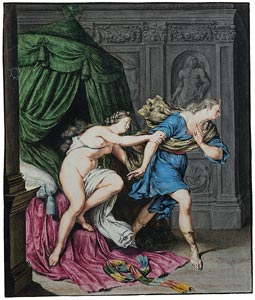
From Rembrandt to van Gogh: Dutch Drawings from the Morgan presented highlights from the Morgan's outstanding collection of Dutch drawings from the seventeenth through nineteenth centuries. When Pierpont Morgan purchased the Fairfax Murray collection of old master drawings in 1909, he acquired one of the most substantial groups of Dutch drawings from the seventeenth century—the golden age of Dutch art—as well as important sheets by eighteenth-century artists. Since the Morgan's founding in 1924, the collection has grown significantly and now extends into the nineteenth century. The Morgan still preserves one of the most comprehensive groups of Dutch drawings in the country. Comprising approximately forty drawings spanning three centuries, the exhibition celebrated the contemporaneous publication of the catalogue raisonné of the Morgan's Dutch drawings.
From Rembrandt to van Gogh opened with drawings by seventeenth-century artists active in Holland. Principal themes of Dutch art emerge in portraits by David Bailly and Jan Lievens, marine views by Hendrick Avercamp and Ludolf Bakhuizen, and pastoral scenes by Nicolaes Berchem. A concern for natural history is revealed in a drawing of tulips by Anthony Claesz. II and a study of a camel by Samuel van Hoogstraten. Genre scenes of alehouse interiors by Adriaen van Ostade reveal the humorous aspect of Dutch art. Rembrandt's achievement as a draftsman was represented by four sheets, accompanied by selections from the Morgan's rich collection of drawings by the artist's pupils, that serve to illustrate the master's influence. The Dutch landscape is a recurrent subject in exhibited drawings by Rembrandt, Jacob van Ruisdael, Abraham Rutgers, and Anthonie Waterloo.
The continuing tradition of draftsmanship during the eighteenth and nineteenth centuries was chronicled by a selection of sheets, including Italian landscape views by Isaac de Moucheron, a genre scene by Cornelis Troost, a powerful head study by Jacob de Wit, pastoral scenes by Aert Schouman and Jacob van Strij, and a watercolor view of the interior of the Oranjezaal (a room in the royal château Huis ten Bosch) by Tieleman Cato Bruining. A luminous vanitas image on vellum by Herman Henstenburgh and a robust study of flowers by Jan van Huysum are characteristic of the ongoing interest in still-life subjects. The exhibition concluded with landscapes by Johan Barthold Jongkind and by Vincent van Gogh, the greatest Dutch artist of the nineteenth century.
Willem van Mieris (1662–1747)
Joseph and Potiphar’s Wife
(Genesis 39:11–12)
Gouache in shades of gray, green, rose, blue, flesh, brown, yellow, orange, and red, on vellum; framing line in black ink
6 3/4 x 5 5/8 inches (171 x 144 mm)
Purchased on the Sunny Crawford von Bülow Fund 1978;
2001.46
